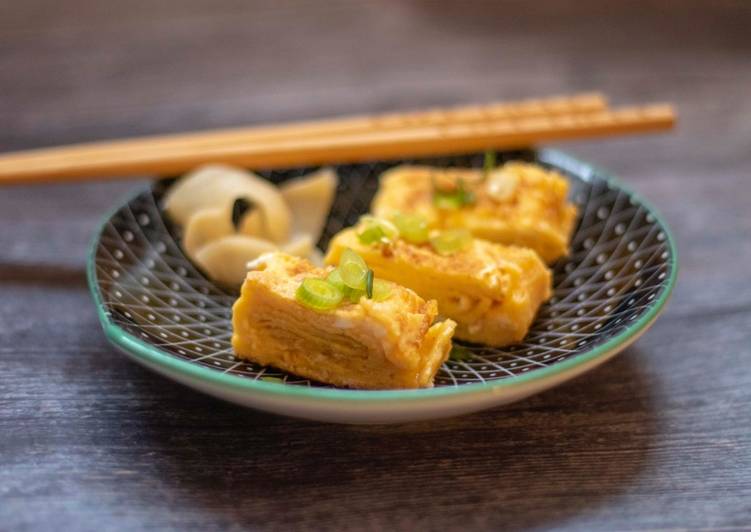
Hello everybody, hope you are having an incredible day today. Today, I will show you a way to make a special dish, tamagoyaki or japanese rolled omelette. It is one of my favorites. This time, I am going to make it a little bit unique. This will be really delicious.
Tamagoyaki or Japanese rolled omelette is one of the most well liked of current trending foods on earth. It is easy, it’s fast, it tastes yummy. It’s enjoyed by millions every day. Tamagoyaki or Japanese rolled omelette is something that I’ve loved my whole life. They are fine and they look wonderful.
Sweet yet savory, Tamagoyaki (Japanese rolled omelette), makes a delightful Japanese breakfast or side dish for your bento lunches. Tamagoyaki (卵焼き or 玉子焼き) is a sweetened Japanese rolled omelette that resemble mini bars of golden pillows. With a slightly sweet taste and custardy texture.
To begin with this particular recipe, we must prepare a few components. You can cook tamagoyaki or japanese rolled omelette using 8 ingredients and 6 steps. Here is how you cook it.
The ingredients needed to make Tamagoyaki or Japanese rolled omelette:
- Make ready 4 eggs
- Take 1 tbsp soy sauce
- Prepare 1 tbsp mirin
- Make ready 1 tbsp dashi stock or vegetable stock or watee
- Make ready 1 tsp sugar
- Get Pinch salt
- Make ready 1-2 tbsp cooking oil
- Prepare 1 spring onion (thin sliced)
Making tamagoyaki requires a special rectangular pan so that the final rolled omelette has a uniform shape. We recommend starting with a smaller. Tamagoyaki is a delicious Japanese Omelette that's a staple of a traditional Japanese breakfast. Whisk eggs, dashi stock, sugar, mirin, and soy sauce together in a bowl.
Steps to make Tamagoyaki or Japanese rolled omelette:
- Beat your eggs well in a bowl using either a fork, or chopsticks. Then add soy sauce, mirin dashi stock and sugar to your mix. Add a bit of salt and mix well again.
- Put a small amount of cooking oil in your pan and bring it up to medium heat. Keep some kitchen roll handy to help keep the pan oiled during cooking.
- Add a small amount (about 2-3 tbsp) of your egg mix into the heated pan. Once the egg has cooked slightly so that the top is still slightly uncooked, push it over to the side of your pan.
- Add a little more oil to the pan using the kitchen roll to wipe the oil over the pan and add another small amount of the egg mix to your pan. Again, wait for your omelette to cook a little, but before it sets on top. You can then begin to roll the first bit of egg over the omelette you just put in the pan until you have a small roll of egg.
- Continue adding a small amount of egg while oiling the pan each time in between. As you add more egg and roll it up each time, your egg roll will start getting larger and easier to add new layers. Keep your hop low heat. Keep adding the egg in new layers until you have used it all up.
- Here you have ii! Your tamagoyaki or Japanese egg omelette. Remove it from the pan and wait to cool before slicing it up into thin pieces. You can sprinkle some thinly sliced spring onions on top. Serve with Japanese rice or put it in bento set.
I am a big fan of Japanese rolled omelet or tamagoyaki-the slightly sweet but delicate omelet that is often packed into Japanese bento boxes and also served at sushi bars as tamago nigiri. Tamagoyaki, a Japanese staple, is made by carefully rolling several thin layers of cooked egg into a rectangular omelet, which creates a soft and delicate texture. I think rolled omelettes are the most popular food here in Japan when it comes to making your lunchbox. With the rolled egg still in the pan, pour in ⅙ of the egg mixture. Lift up the rolled egg and let the mixture to flow under it.
So that is going to wrap this up with this exceptional food tamagoyaki or japanese rolled omelette recipe. Thanks so much for your time. I am confident you can make this at home. There’s gonna be more interesting food at home recipes coming up. Don’t forget to save this page on your browser, and share it to your family, colleague and friends. Thanks again for reading. Go on get cooking!


